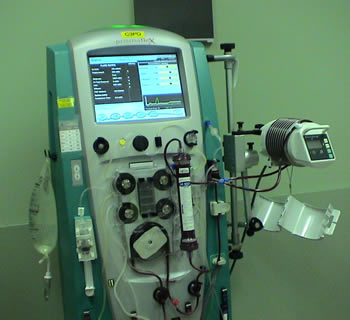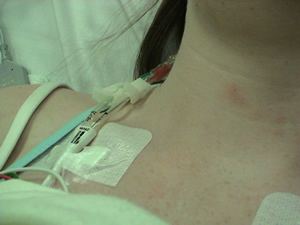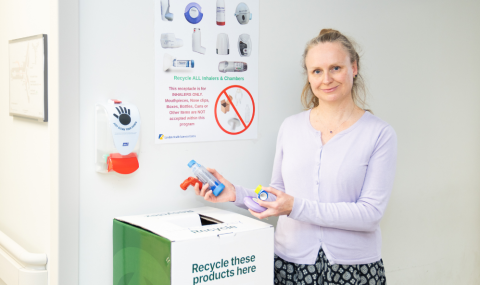|
DIALYSIS Health individuals have two kidneys. About 180 L of blood will flow through the vessels of the kidney each day. Blood will flow into the microscopic vessels of the kidney (called the glomerulus), where water and waste products are filtered out as urine. Urea and creatinine are two of the waste products that are filtered by the kidney. The medical term for kidney is "renal". The medical term that is used to describe kidney's that are not working properly is renal failure. Acute renal failure is a term used to describe renal failure that develops suddenly. This is common during critical illness, and frequently occurs as a result of low blood flow. Infection and certain medications can also injure kidney cells (called nephrons). If enough nephrons are damaged, water and waste products cannot be eliminated fast enough and they will accumulate in the blood. The patient with kidney failure often develops a lot of edema (swelling) from water that leaks into the tissues. Edema can collect around the lung causing breathing and/or heart failure. Waste products can accumulate in the blood leading to a number of metabolic problems. Dialysis is a life-support procedure that is initiated when the kidneys fail. In critical care, dialysis is provided as either Intermittent Hemodialysis (IHD) or as Continuous Renal Replacement Therapy (CRRT). Intermittent treatments are provided for a few hours each day or every 2-3 days. Continuous methods provide slow and continuous dialysis on a 24-hour per day basis. Both methods use the same principles; the difference between the two is the speed of dialysis. "Hemo" means blood. Dialysis is the removal of water (called ultrafiltration) and/or waste products (called clearance) using an artificial kidney (dialysis filter). To dialyze a patient, a large double lumen catheter is inserted into a central vein. This specially designed catheter is called a dialysis catheter. The dialysis catheter is often referred to as the Access Site. Dialysis catheters can be easily recognized because one limb of the catheter is red and the other is blue. Tubing is connected to the dialysis machine and flushed with fluid. The tubing is connected to the dialysis catheter. The red lumen of the catheter is used to remove blood from the patient while the blue end is used to return the blood. Prior to return to the patient, the blood passes through the dialysis filter where water and waste products are removed. Many patients who develop an acute episode of renal failure will recover without the need for permanent dialysis. Other patients who develop renal failure will need dialysis for the rest of their lives. It is often difficult to know for sure which patients will recover the function of their kidneys. Patients can be dialyzed every day or two for short periods of time (2-5 hours). Very large amount of water and waste are usually removed. This type of dialysis is called Intermittent Hemodialysis (IHD). Patients with permanent renal failure (called End Stage Renal Disease), who are receiving hemodialysis, will be managed with Intermittent Hemodialysis. Critically ill patients may also be treated with Intermittent Hemodialysis. Intermittent Hemodialysis treatments are run by a dialysis nurse who will come to CCTC with an IHD machine. The large amount of fluid removed during hemodialysis is not always tolerated by critically ill patients. During critical illness, we may choose to dialyze patients using Continuous Renal Replacement Therapy (CRRT). In CCTC, CRRT is often called "Prisma" or "Prismaflex". This is the name of the continuous dialysis machine that we use. CRRT is run by one of a core group of CCTC nurses who have received additional education in CRRT. Continuous Venous to Venous Hemodiafiltration (CVVHDF) is a term that is used to desribe common CRRT therapy. The therapy is continuous, and uses a double lumen venous catheter (venous to venous). A blood pump (on the dialysis machine) is required to remove and return the blood. Hemodialysis fluid is infused around the blood filled filter to apply the principles of diffusion. Waste particles will move from an area of high concentration (from the blood) toward an area of low concentration (the dialysis fluid). The "filtration" component of the therapy involves the removal of large volumes of water across the filter. As the wave of water fluxes across the filter, additional waste products are "dragged" across the filter and removed. The water is returned to the patient to prevent dehydration. CRRT is a continuous, 24-hour per day treatment. Fluid and waste products are removed slowly, at a rate similar to the natural kidney while this is better tolerated by patients with blood pressure problems, patients who require long term dialysis will eventually be switched to an intermittent mode of therapy. |
|
|
Continuous Renal Replacement Therapy machine (CRRT). |
|
|
Image 3: Dialysis catheters look like central lines but can be identified by the red and blue connections. |
|
|
|
|
|
|
Last Updated: October 23, 2014




